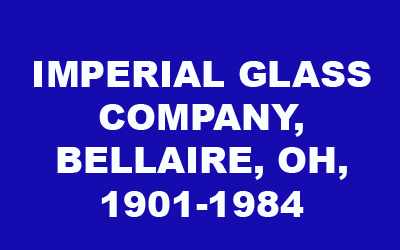|
 |
|
|
Glass Etch and Pattern Gallery
|
|
|
 |
|
|
|
|
|
|
|
|
|
|
|
|
|
History of Imperial Glass Company

| History of Imperial Glass Company |
Imperial Glass Company, Bellaire, Ohio (1901-1984). The company was founded in 1901 by a group of investors from Wheeling, West Virginia and Bellaire, Ohio. After spending several years constructing a building and making molds, glass making finally began in 1904. At this time, it was the largest glass factory under a single roof in the world. Initially, production consisted of clear pressed tableware for five and dime stores, with their first major sale being to F. W. Woolworth, but by the end of the decade they were beginning to expand their horizons. In 1909 they introduced their first iridescent glass in a marigold color they called rubigold. In 1911 they introduced pressed reproductions of ?early English cut glass? under the NuCut label. The NuCut crystal line was popular and the items were often given away as premiums. In 1912 they added Tiffany style lampshades under the NuArt label and in 1916 they developed a beautiful line of iridescent glass with a unique onion-skin effect that collectors refer to today as ?stretch glass.? This is the glass that is sometimes called ?Imperial Jewels? by collectors, although Imperial never used that name.
Loss of market share due to competition from machine-made glass companies and the onset of the depression forced Imperial into receivership in 1931. J. Ralph Boyd purchased the assets at a public auction in July of 1931 and the company was reorganized as the Imperial Glass Corporation in August of that same year. With the help of a new management team and two very popular new patterns (Cape Cod and Candlewick) they were able to get back on their feet and eventually return to prosperity.
In 1940 they purchased many molds from the Central Glass Works and in 1958 they acquired the same from the A. H. Heisey Company, along with all rights to the name. Many Heisey patterns were reissued, some in Imperial?s colors, under the name ?Heisey by Imperial.? In 1960, they acquired the assets of the Cambridge Glass Company. They reissued the Rose Point etching and other Cambridge patterns, including the ?Cambridge Arms? candelabra, which became strong sellers in the Imperial lineup.
Through an exchange of stock in 1972, Imperial was acquired by Lenox, Incorporated. By the middle of 1981, a private investor, Arthur R. Lorch, purchased the company from Lenox. At the end of 1982 Lenox foreclosed on its note with Mr. Lorch and the company was sold to Mr. Robert F. Stahl, Jr., who immediately filed for Chapter 11 bankruptcy in order to reorganize the company. A small amount of glass was made with an NI mark for ?New Imperial? but production ceased for the last time on June 15, 1984. In August 1984 liquidation was ordered and the assets were sold to the Lancaster Colony Corporation, including many of the molds. The building was sold in 1985 and has since been razed. ? From The Glass Candlestick Book, volume 2, by Tom Felt, Rich & Elaine Stoer (reprinted with permission) |
| Keywords: |
|
| Date: |
22.04.2007 01:31 |
| Hits: |
4460 |
| Added by: |
Tom Felt |
|
|

Powered by 4images 1.9
Copyright © 2002-2024 4homepages.de
Copyright © 2003 - 2019 Glass Etch and Pattern Gallery. All rights reserved, foreign and domestic.
|
|
|
|

